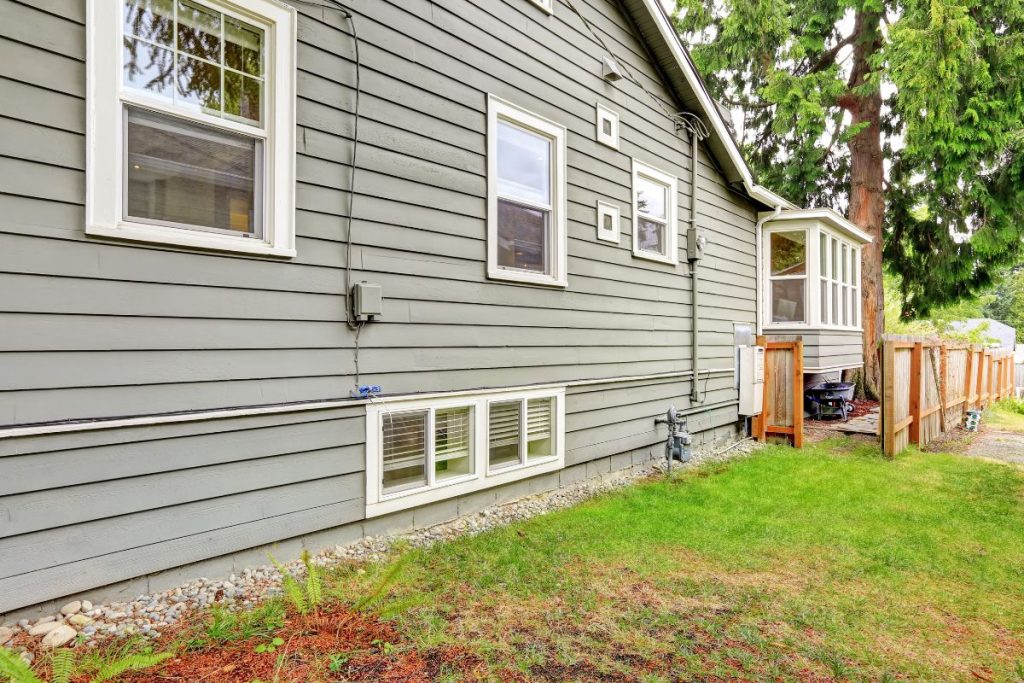Clapboard siding isn’t just some old-school design move, it’s one of the most iconic ways to dress up a house. Think overlapping wooden boards lined up to create clean shadows and sharp curb appeal.
The style is classic, but it’s also practical. It keeps rain out, holds up well, and adds instant character to any home. You’ll see it on New England cottages, modern remodels, and everything in between.
If you’re weighing your siding options, clapboard gives you that balance of style and function. It’s easy to spot, easy to love, and it’s got a track record that proves it’s more than just a pretty face.
What makes clapboard siding unique?
Clapboard siding features overlapping horizontal boards that create a timeless look while protecting homes from wind and rain.
Key Takeaway
- Clapboard siding = classic overlapping boards with timeless curb appeal.
- Available in wood, vinyl, and fibre cement.
- Pros: style, durability, easy repairs.
- Cons: maintenance, moisture risk, higher upfront costs.
- Best choice if you want style + function with moderate upkeep.
History and Origins
Clapboard siding has roots in early colonial America. Settlers needed a practical way to shield homes from wind and rain, and overlapping wood planks did the trick.
By the 17th century, it was the go-to look for New England houses. The simple design wasn’t just about weather protection, it created a clean, uniform style that still feels fresh today.
Fast-forward to now, and the same concept lives on with modern materials like vinyl. You get the classic layered look without the upkeep headaches of old wood. It’s a cheat code for nailing that timeless vibe while keeping your weekends free from sanding and painting.

Materials Used for Clapboard Siding
Clapboard siding has always been about clean lines and strong vibes, but the material you choose sets the tone. Traditionally, wood ruled the game, giving homes that timeless, classic flex. It’s smooth, natural, and can be painted to match your style.
Modern options like vinyl bring a different cheat code. They’re lightweight, low-maintenance, and built to resist fading or warping. You’re basically getting the look without the upkeep drama.
There’s also fibre cement, which is like the heavyweight champ of siding. It holds up against harsh weather and still keeps its shape. The takeaway? If you want classic charm, go wood. If you want hassle-free, vinyl is your move. And if you want all-season toughness with a sleek finish, fibre cement’s the upgrade.
Key Features of Clapboard Siding
Overlapping Design: Each board slightly overlaps the one below, creating a tight fit. That overlap isn’t just for looks, it helps keep rain and drafts out.
Classic Look: Clapboard siding has that clean, horizontal line you’ve seen on timeless New England homes. It gives your place instant curb appeal without trying too hard.
Durability: Built to handle different weather conditions, clapboard siding can stand up to both heat and cold. With the right upkeep, it stays sharp for years.
Easy Repairs: If one board gets dinged, you don’t need to redo the whole wall. Just swap out the damaged piece and you’re good.
Advantages of Clapboard Siding
Clapboard siding has serious curb appeal. Those clean horizontal lines give your home a timeless, tailored look that never feels out of style. It’s basically the crisp white tee of exterior finishes, always classic.
It’s not just about looks, though. The overlapping boards are designed to shed water, so you get solid protection against rain and moisture. That means fewer headaches with rot and leaks down the road.
On the practical side, clapboard is easy to repair. If a single board gets damaged, you don’t need to redo the whole wall, just swap that piece out. Combine style, durability, and straightforward maintenance, and you’ve got siding that actually earns its keep.
Potential Drawbacks
Clapboard siding looks sharp, but it’s not totally hands-off. Wood versions need regular painting or sealing, or you risk rot and warping. Even vinyl can crack if it takes a hard hit.
Moisture is another thing. If water sneaks behind the boards, mould can start flexing in your walls. The fix? Professional installation with proper flashing and routine check-ups.
Cost-wise, higher-end clapboard isn’t always budget-friendly. But if you plan ahead and keep up the maintenance, you’ll get the style without constant stress.
Clapboard Siding vs. Other Siding Types
Clapboard siding gives you that classic, layered look that vinyl panels often try to copy but rarely nail. It flexes between timeless charm and modern curb appeal without looking dated.
Compared to shingles or board-and-batten, clapboard feels cleaner and more versatile. It’s easy to paint, repair, and style without locking you into one vibe.
If you want siding that balances tradition with an adaptable edge, clapboard is the cheat code. It’s the safe bet that still lets your house flex some personality.
Installation Process Overview
Prepping the Walls: First step, make sure the surface is flat and weather-ready. Any bumps or rot? Fix those before you even touch the siding.
Starter Strip Setup: Install a starter strip along the bottom edge. This acts like your baseline, keeping every board straight.
Layering the Boards: Each clapboard overlaps the one below. Think shingles, but horizontal. That overlap keeps water out and gives you the classic look.
Securing the Siding: Use nails through the thickest part of the board. Don’t overdrive them, or you’ll mess with movement and cause cracks.
Maintenance and Care
Clapboard siding doesn’t need constant babysitting, but it does like attention. Wash it down once or twice a year to keep dirt and mildew in check.
Check for peeling paint, cracks, or loose boards, then handle repairs before they snowball. A fresh coat of paint every few years keeps it looking sharp.
Think of it like keeping sneakers clean – quick touch-ups now save you from a major overhaul later.
Cost Considerations
Clapboard siding isn’t a one-size-fits-all price tag. Costs shift depending on the wood type, finish, and the size of your home.
Keep in mind, cheaper options might save you upfront but need more upkeep later. Higher-end materials cost more initially yet hold their look longer with less fuss.
The smart move? Factor in both the installation and long-term maintenance. Think of it less as a quick purchase, more like an investment in your home’s style and durability.
Is Clapboard Siding Right for Your Home?
Clapboard siding works if you want that clean, timeless look without fuss. It’s durable, easy to repair, and fits almost any style of home. If you’re after curb appeal that flexes both tradition and low-key luxury, clapboard nails it.
Just make sure you’re cool with occasional upkeep, because even the best drip needs maintenance.
FAQs on Clapboard Siding
1. How long does clapboard siding last?
With proper care, clapboard siding can hold up for decades. Regular cleaning and painting help it stay fresh.
2. Is clapboard siding expensive?
It’s usually mid-range in cost. The price depends on the material type and professional installation.
3. Does clapboard siding need a lot of maintenance?
Not a ton, but you’ll need to repaint or reseal it every few years. That’s the tradeoff for its classic look.
4. Can clapboard siding handle bad weather?
Yes, especially if installed right. It sheds water well, but keeping paint intact is key to stopping rot.
5. What’s the biggest flex of clapboard siding?
Style. It’s timeless, instantly boosts curb appeal, and makes your home look like it belongs on a magazine cover.
Conclusion
Clapboard siding is a classic look with real staying power. It’s low-key stylish, durable, and works with both modern and traditional homes. If you want curb appeal without overthinking it, this siding nails the brief. Pair it with pro installation and you’ll have a setup that looks good and lasts.








